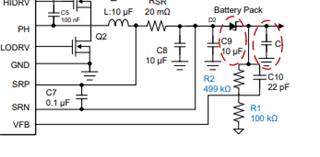Hi,
We implement code to prevent BQ24650 leakage current as described in TI document SLVA829.
The method we used was a Mosfet in the MPPT pin, and that works adequately.
In the first test we set two values that are (95% x Vmp) and (90% x Vmp).
When the solar panel voltage rises above (95% Vmp) we remove the shutdown the BQ24650, and when it falls below (90% Vmp) we force the BQ24650 to shutdown.
In the measurements we made without solar panel (solar panel voltage = 0) , we found that the total consumption of the MPPT charger board remains the same, i.e. we did not measure any reduction in consumption as we expected.
We did a second test, where in addition to the condition of having the solar panel voltage less than 95% of Vmp, we only shutdown the BQ24650 when simultaneously the solar panel voltage was HIGHER than the battery voltage at that moment.
The measurements never showed a reduction in MPPT charger board consumption in the above described condition.
We have confirmed that the MPPT pin of the BQ24650 is forced to zero volt, when we shutdown the BQ24650.
In the tests we used a solar panel simulator, and a battery simulator to set the above values.
We don't understand why there isn't at least a slight reduction in current consumption when we shutdown the BQ24650 as described above.
On the other hand we don't know what the best algorithm to force and remove the shutdown from the BQ24650 is.
Is it any of the algorithms described above, even with another percentage of Vmp, or another one that we haven't used so far?
Reading the manual it was not clear how we can, in theoretical terms, calculate the current that the BQ24650 draws from the battery when the solar panel voltage is between Vmp and Vbat.
Any information and comments regarding the above described is welcome.
regards
Jose




 but ignores resistor tolerance. I assume you are using a second resistor divider off the panel and using the ADC to measure that voltage? If so, worst case +/-0.6% +/- 1% resistor tolerance, should be good enough.
but ignores resistor tolerance. I assume you are using a second resistor divider off the panel and using the ADC to measure that voltage? If so, worst case +/-0.6% +/- 1% resistor tolerance, should be good enough.